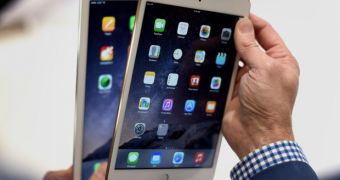A renowned figure in the technology sector, Dr. Raymond M. Soneira, who works with DisplayMate Technologies, has released a paper containing an in-depth analysis of the iPad Air 2 and iPad mini 3 displays.
Right off the bat we can tell you that Soneira is not very impressed with Apple’s display endeavors as of late, but there’s one particular enhancement that he deeply appreciates and hopes that more vendors will go down the same path.
Of the two new iPads unveiled by the company earlier this month, only one is really worth buying. It’s not just Soneira’s opinion, but everyone else’s too. The reason is simple. The iPad Air 2 got better everything, while the iPad mini 3 is simply an iPad mini 2 with a Touch ID for a Home button. Needless to point out, there’s even more incentive now to buy the $100 / €100-cheaper iPad mini 2.
But that’s beside the point. What we’re here to look at is Dr. Soneira’s take on Apple’s recent developments in the display department.
Anti-glare display
One key paragraph from his paper states that “A major innovation for the iPad Air 2 (that is not fully appreciated) is an anti-reflection coating on the cover glass that reduces ambient light reflections by about 3:1 over most other Tablets and Smartphones (including the previous iPads), and about 2:1 over all of the very best competing Tablets and Smartphones (including the new iPhone 6).”
Apple has made similar efforts in the desktop department. The 2012 iMac was the first to get an anti-reflective coating that reduced a fair amount of ambient light reflections (about 30 percent, if our memory serves us right). There was one compromise, though. Smudges became even more visible.
Truth be told
Soneira continues, this time telling the rest of the iPad display story.
“However, other than the new anti-reflection coating and bonded cover glass, the display on the iPad Air 2 is essentially unchanged and identical in performance to the iPad 4 introduced in 2012, and is actually slightly lower in performance than the original iPad Air (for example 8% lower Brightness and 16% lower display Power Efficiency) – most likely the result of an obsession with producing a thinner Tablet forcing compromises in the LCD backlight.”
In other words, while your iPad Air 2 will be more usable in daylight, it will probably not offer an improved visual experience over the original iPad Air. That’s okay, though. The first iPad Air has an awesome display as well, regardless of what the experts might say. After all, it takes a well-trained eye to spot flaws in a display whose pixels become indistinguishable inches away from your face.

 14 DAY TRIAL //
14 DAY TRIAL //